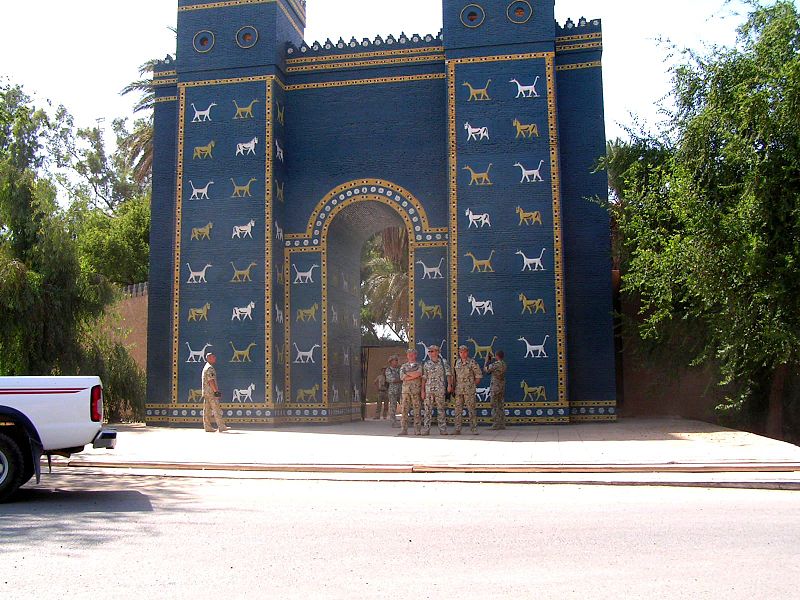According to a new UNESCO report American troops and contractors have caused "substantial damage to the archaeological site at Babylon in Iraq after the 2003 invasion". John Curtis, an archaeologist from the British Museum, stated that soldiers most likely broke loose pieces of stones from the ruins as souvenirs. This reminded me of Michael B. Oren's description of American tourists in Egypt in the 1870s:
"About the only time, it seemed, that Americans dallied in the Middle East was to desecrate or pillage its monuments. On pyramids and tombs and obelisks, Americans left their mark in the form of brilliantly rendered Stars and Stripes and hieroglyphs hastily chiseled off. [...] And what they could not steal or vandalize, Americans were ravenous to buy. [...] The disrespect that Americans displayed for the classical past of the Middle East was only exceeded by their contempt for its contemporary society" (p. 230)
An illustration in his book Power, Faith and Fantasy - American in the Middle East 1776 to the Present shows American female tourists chipping souvenirs from a column in an ancient Egyptian temple, where they are "saving precious fragments from the ruin to which they are doomed".
There is of course a big difference between soldiers in Iraq and the tourists mentioned, both in time and in reasons for being there. The damage in Babylon is also not caused by tourism, but by war and carelessness. In Babylon the Americans had an army base in 2003-2004 were (from BBC News):
"[...] troops and contractors dug long trenches through the ancient ruins, bulldozed hilltops and drove heavy vehicles over the fragile paving of pathways which were once held sacred."
Dragon carvings on the famous Ishtar Gate have also been heavily damaged. It might be important to mention that parts of this gate is spread across museums all over the world and that the Americans are not the only ones taking bits and pieces back home from abroad. A reproduction of the gate serving as an entrance to an unfinished museum, built in Iraq during Saddam Hussein has also been damaged by the war.

The US also stated that the damages and looting in Babylon when under their control would have been worse if they had not been there at all. A bit hard to believe when Donald Rumsfeld, Defense Secretary at the time, stated on the looting in Iraq after the invasion that "stuff happens" and that the looting was a "part of the price" for the liberation of Iraq. With such a mindset from the very top it is hard not to see "the disrespect that Americans displayed for the classical past".
These damages are a violation of the the 1954 Hague Convention for the Protection of Cultural Property in the Event of Armed Conflict and the notion of military necessity, but this convention is usually ignored during war and conflicts the world over. Some of the damages to Babylon can be seen here.
The UNESCO Report (pdf): FINAL REPORT on Damage Assessment in Babylon by International Coordination Committee for the Saveguarding of the Cultural Heritage of Iraq
An earlier report from December 2004: Report on Meeting at Babylon 11th – 13th December 2004 (includes a few maps of the area)
Conclusions from the latter:
- About one dozen trenches, the largest 170m long, and about one dozen cuttings, have been made both into previously undisturbed archaeological deposits and into tips or mounds from earlier excavations. In these trenches were found pottery (including a complete vase), bones and fragments of brick with cuneiform inscriptions.
- About 300,000 sq. metres of the site have been covered with gravel, sometimes compacted and chemically treated, to be used as a helipad and to create spaces for vehicle parks, accommodation, storage, etc. All the gravel has been brought in from elsewhere, and will in due course work its way into the archaeological deposits, irrevocably contaminating them.
- Around the site are thousands of sandbags and HESCO barriers that were originally filled with earth scooped up from the Babylon archaeological site (the presence of sherds and bones in the bags is a testimony to the archaeological nature of the deposits used) and from 3rd November 2003 onwards filled with sand and earth brought in from outside Babylon, sometimes no doubt from archaeological sites, thus exacerbating the problem even further.
- In many parts of the site are wheel marks deriving from the movement of heavy vehicles, and damage is also likely to have been caused by the extensive helicopter traffic at the site.
- There is evidence of environmental pollution (fuel seepage) in the area of the Fuel Farm. This is likely to have a deleterious effect on the archaeological deposits beneath.
- There is damage to 9 of the moulded brick figures of dragons in the Ishtar Gate, in one case serious damage to the body of the figure.
- The brick pavement in the south part of the 6th century BC Processional Way has been broken by driving a heavy vehicle along it.
- Parts of the roof of the (reconstructed) Ninmah Temple have collapsed.
